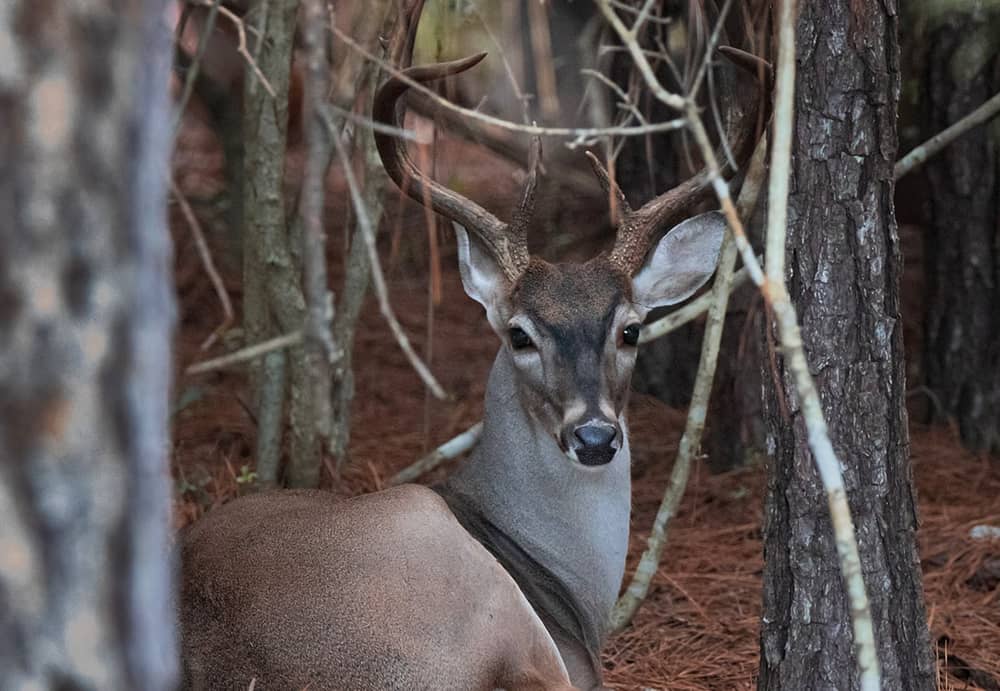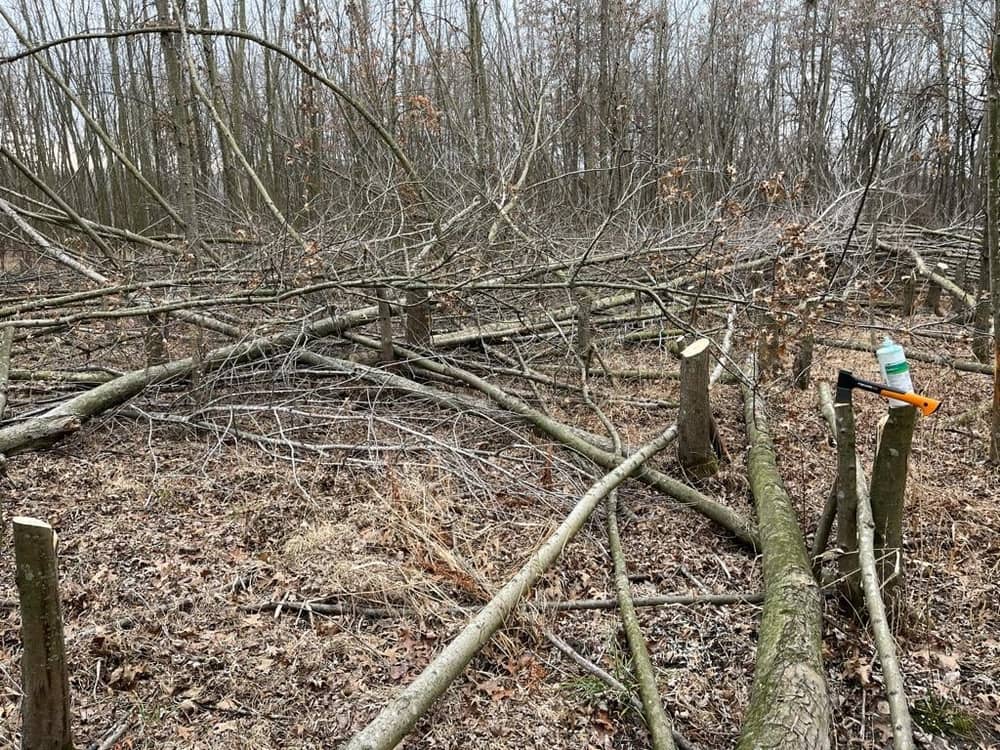Cutting hinges is a simple habitat improvement that has grown in popularity recently. Because more land is being micromanaged to support more species, enhance the hunting experience, and boost the likelihood of hunting success. This is the reason why hinge cut trees for deer.
Hinge cutting increases the density of open spaces and provides deer with bedding, food, and cover. This also makes it possible for trees that produce soft mast for deer to receive more water and nutrients.
Hinge cutting can significantly alter your experience, regardless of whether you enjoy hunting or simply watching animals in its natural setting.
A modified environment can draw in more wildlife by altering the landscape of that area. After that, give hunters more opportunities to enjoy themselves. In this article, we will explore more about hinge cutting trees and its effect on deer habitats.
Table of Contents
Purpose of Hinge Cutting
Hinge cutting is a forestry management practice in which a tree is partially chopped, leaving a strip of bark clinging to the stump. The goal of hinge cutting is to increase forest health and generate more wildlife habitat.
By cutting the tree at an angle, it can be directed to fall in a specific direction, forming a “hinge” of bark that aids in controlling the fall’s path. This method can be used to generate dense cover, browse, and bedding areas for wildlife. By enabling more sunlight to reach the forest floor, it can also aid to foster the growth of young trees and other vegetation.
Hinge cutting is also useful for controlling forest pests such as invading species and sick trees. The overall health of the forest can be improved by strategically pruning trees in places where pests are present.
Generally, hinge cutting is a strategy for improving forest health, promoting wildlife habitat, and managing forest pests.
We are all aware of how important our forests are to the hunting world and how they are the natural habitat of the deer that we so avidly chase.
The health of the wood can benefit greatly from hinge cutting. By removing trees, you can encourage regrowth by allowing more sunshine to reach the forest floor. Younger vegetation can develop significantly more quickly as a result. Also, it enables young trees to get sunlight, which promotes their faster and healthier growth.
Why Hinge Cut Trees For Deer?

Hinge cutting encourages the growth of natural plants that deer will consume and young trees. Also, if you leave the necessary quantity of meat on the tree, it could survive for years and provide a huge amount of food that the deer wouldn’t otherwise have.
The deer would have sprouts from the stump even if you entirely removed the tree. Although not a long-term solution, this. Trees can continue to produce leaves and shoots that deer find appealing by being hinge cut.
Making funnels is another wonderful advantage of hinge cutting. Consider mapping a buck’s early-season itinerary from his bedding area to the food patch. Through hinge cutting, you may be able to alter his course and make him take a detour that brings him closer to your position.
Deer now have a spot where they shouldn’t ever feel endangered. It has plenty of food, cover, and a strong wind. More importantly, there was absolutely no human presence. This kind of habitat can be made with the aid of hinge cutting.
To create a canopy that deer can enter, trim bedding patches at chest height. You’ll be astounded by the dense, unpleasant cover that emerges from a few hinged-cut trees.
Although these recommendations primarily favor deer and deer hunting, they are beneficial to all wildlife. These hinge cutting recommendations will increase food and cover for a variety of animal species.
The fresh, live brush heaps will make excellent screening and hiding places for rabbits. Edge feathering, changing bedding locations, and releasing browsing areas will all significantly improve quail habitat.
The habitat ought to respond favorably to offer improved broadleaf ground cover for nesting turkeys. Increased mast production will benefit squirrels and other animals. The advantages to other wildlife species are innumerable.
How To Cut Trees In A Safe Way?

An effective tool for regulating deer habitat is hinge-cutting. Yet it is only one technique, and it has certain uses. It can be harmful and unhelpful if used improperly. Here are some pointers to assist you understand how to safely cut hinges.
Preparing
Avoid cutting alone because while you are focused on cutting, two individuals can see hazards above and around you. Many dead limbs from neighboring, larger trees may be ready to fall to the ground with just a tiny brush from the tree you are hinging. In the event of an accident, your spotter can help keep you safe and contact aid.
Safety depends on having effective tools and protective gear. Quick cuts can be made using a chainsaw that is lightweight and has a sharp chain, and the rate of tiredness is reduced.
For smaller trees and inexperienced chainsaw users, a sturdy, sharp bowsaw might be the best option. For everyone though, gloves, safety glasses, chaps while using a chainsaw and a hardhat are important.
Choosing Trees for Hinge Cutting
Make sure to pick the best-suited trees to hinge before beginning your hinge cutting. For the long-term health of your forest, choosing the proper species for your hinges is also crucial.
Making the right decisions up front will aid in reducing the workload and inputs over time. The best diameters for hinges are typically six inches or smaller. Usually, warm weather and active tree fluids make for favorable hinge cutting circumstances.
Cutting Technique
Contrary to what you would believe, a consistent hinge requires a different method. This updated cutting method merely makes an angled 45-degree downward cut. Although it takes a bit longer to get going, this approach regularly yields superior outcomes.
At knee and waist height, a decent hinge usually only penetrates the tree two-thirds to three-quarters of the way, leaving just enough holding timber for you to drive the tree to the ground. According to the species of tree, the more of the tree you leave standing after it is cut down, the more growth you’ll get from the stump.
Choose a tree species native to the area that is ideal for hinge cutting. Small to medium-sized trees with a diameter of 3 to 10 inches are perfect for hinge cutting. Large trees should be avoided since they can be dangerous and can harm the ecosystem.
The cutting height is the point on the tree trunk where the hinge will be made. This should be between waist and chest height, or at a level that provides animal cover.
Create the hinge by cutting a portion of the tree trunk from the opposite side of where you want the tree to fall. Leave a tiny section of the tree untouched to act as a hinge, allowing the tree to fall slowly while remaining linked to the stump.
Make the back cut by cutting through the remaining tree trunk from the opposite side of the hinge. The tree will start to fall and should land on the hinge, which will keep it attached to the stump.
After the tree has fallen, arrange it to provide cover and food sources for wildlife. You can, for example, lean the tree against another tree or leave it on the ground to form a barrier or thicket.
Safeguarding Saplings And Seedlings
Hinge cutting can also be used to protect natural regrowth or tree plantings. In order to create a physical barrier that prevents browsing and rubbing, trees can be hung and seedlings can be inserted into the tops.
You can lessen competition for your new seedlings by applying herbicide as a basal or hack-and-squirt treatment to the damaged or unattractive trees. The protection of natural regeneration can be achieved by identifying trees that are at risk and then simply hinging the trees around them.
Final Thoughts
Why hinge cut trees for deer? The practice of hinge cutting trees for deer can benefit the ecosystem and wildlife populations. Hinge cutting can provide essential habitat for deer and other wildlife species by generating dense cover and a varied range of food sources. Furthermore, hinge cutting can be a cost-effective and long-term method of managing wooded regions for animals.

